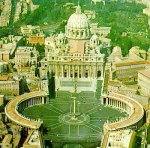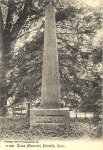lamentablemente para ti delirio elena conocía el obelisco.
lee el documento del white estate donde lo confirma
http://drc.whiteestate.org/createpdf.php?emailid=41680
Subject: Obelisk on Ellen G. White's Grave?
Sep. 15th, 2008
Answer
!
Dear Brother _______,
Thank you for contacting the Ellen G. White Estate. There is indeed an obelisk on the family plot where Mrs. White and
her husband are buried, though it is not the tombstone for either of them, but rather serves as the family marker in the
center of the plot. Some people have expressed surprise and concern to find an obelisk on the White family plot because of
the obelisk's connection to pagan worship in Egypt and to other questionable associations. Evidently, however, many
people in the 19th century didn't think this was a problem. Adventists of that era seem to be among them. While looking
for something else, we recently found correspondence relating to this question among the letters of George I. Butler, who
was General Conference President when James White died in 1881 and for a number of years after. On February 12, 1884,
Elder Butler wrote to Mrs. White,
"The dark colored granite monument at B.C. [Battle Creek] which you looked at I ordered for your husband's grave last
week at your son Willie's invitation. He told me to have it charged to you. I regret to do this while the money lies in the
office which his friends contributed to show him respect for his memory. Will desired me to have this money put in the
European Mission Board, but I don't feel that I am authorized to do that without their consent. There is about $170 now in
the office for that purpose and more that is subscribed which would be paid in if called for."
This indicates that Mrs. White had seen the monument, and perhaps her son W. C. White had as well. W. C. White gave
Elder Butler approval for its purchase. A letter from Elder Butler to W. C. White on February 10 of that year discusses the
cost of the monument "with the headstone and other stones" and says that it "will be erected as soon as you send on the
inscription." It is clear that the White family was involved in the selection of the monument.
Twenty years later, in 1904, Mrs. White wrote about a different suggestion for James White's monument:
After my husband had been laid away in the grave, his friends thought of putting up a broken shaft as a monument.
"Never!" said I, "never! He has done, singlehanded, the work of three men. Never shall a broken monument be placed over
his grave!" ... {1SM 105.1}
We can only guess, but it may be that in contrast to that suggestion, she was quite pleased to have such a well-formed,
symmetrical monument placed on the family plot.
Some have asked about the obelisk and its supposed connection to Freemasonry. Seeing the obelisk on the family plot, a
few have even supposed that Mrs. White must have been involved herself in the Masonic movement. This is an
unwarranted conclusion. Mrs. White was an outspoken opponent of Freemasonry. While she was in Australia, she was
even shown two secret signs of high-ranking Masons, which she made in the presence of an Adventist worker who was
deeply entangled in Freemasonry. She urged him to sever his connection with it. She also counseled others not to be
involved with Masonic orders.
So why the obelisk? Evidently she did not regard it as inherently a Masonic or pagan symbol, regardless of the fact
(whether known to her or not) that Masons and sun worshipers had used it. Symbols mean what people take them to mean.
The cross itself was once an abhorrent symbol of Roman oppression and cruelty, but today Christians around the world
hold it as a symbol of our redemption through Christ. Symbols may change their meaning. I remember being shocked once
to see in an old synagogue a symbol that I would call the swastika. Nazi Germany gave that symbol a certain meaning, but
evidently it had not always had that meaning. When James White began to publish the Review as a bi-weekly publication
(it became weekly in September of 1853), along with the date of publication he soon gave the standard name for the day of
the week on which it was published, whether Monday or Thursday (the day of publication varied some in those days).
Page 1/2
© Ellen G. White Estate
Subject: Obelisk on Ellen G. White's Grave?
Sep. 15th, 2008
Soon, however, he made a change. The issue published "Thursday, May 12, 1853," was followed two weeks later by the
one published "Fifth-day, May 26, 1853." For several decades the paper designated its publication day variously as
"Fifth-day" and "Third-day" (for Tuesday), apparently out of concern over the days' having been named for pagan gods.
By the January 1, 1880, issue, however, the practice returned to using the standard names. Apparently our pioneers
decided by then that the use of those names carried no compromise of their faith. No one using those names today makes
any devout reference to the pagan gods. The names simply don't symbolize those gods for people today, regardless of what
they may once have meant. Similarly, whatever occult meaning may once have been communicated by an obelisk, as far
as I know, by the 19th century at least, this meaning seems no longer to have been operative for people generally, though it
did have continued mystic significance for Freemasons. Clearly, though, Mrs. White did not hold such beliefs.
I hope this helps. Thank you for writing, and God bless!
William Fagal
Associate Director
Ellen G. White Estate
12501 Old Columbia Pike
Silver Spring, MD 20904-6600 U.S.A.
Phone: 301 680-6550
FAX: 301 680-6559
E-mail:
[email protected]
Web:
www.WhiteEstate.org
Question
?
Good day,
I am a SDA and have been told that Ellen White and her husband each have an obelisk over there grave. Is this true, and if
it is, could you tell me the history of it or direct
me to some sources so i can reasearch it myself?
Thanks,









